For a long time now, players who have sought to forge a professional career in the USA have had just one option when it comes to finding a league.
The NWSL is the country’s sole fully professional division and, therefore, the only place where they could realistically ply their trade.
However, there is now an alternative available in the form of the all-new USL Super League.
The inaugural campaign got underway back in August, and an initial eight teams (with more set to join in years to come) competed for glory.
The league, the brainchild of business executive Amanda Vandervort, is more exciting because it is more closely aligned with the international calendar and system.
It runs from the autumn through to the spring and does not use a Draft system to build squad rosters.
As a result, it offers a very different product for players and fans alike and is seen by many as a breath of fresh air in the American women’s game.
With the campaign already six weeks old, fans have had a good opportunity to assess each side’s credentials and make judgements about how they could perform.
One that has particularly impressed is Carolina Ascent FC.
Based in Charlotte, North Carolina, and coached by Philip Poole, they currently top the standings after three wins in their opening four matches and two clean sheets.
They clearly understand the need for exciting attacking play and solidity at the back.
Not everything has been perfect, and this tactical analysis will highlight areas where they can still improve.
Still, there is certainly a lot to like about them, and there is no doubt that they are among the contenders to lift the trophy when the season reaches its conclusion next May.
Carolina Ascent’s Adaptability In Attack
Whilst defending remains a critical aspect of any team’s performance, the demands of the modern game are such that exciting attacking play will always be more highly favoured.
When watching Carolina Ascent FC, it is clear that they understand that and have a natural desire to get on the front foot, but they can do so in different ways.
Adaptability is critical, as it means that they always have a fallback option if their initial game plan fails to have the desired effect.
This has made it so difficult for them to be completely shut out.

Their tactics have mostly revolved around keeping the ball on the ground and shifting it through the lines progressively without holding onto it for too long in the same area of the field.
They look to prevent their opponents from getting into their shape and sealing off potential passing routes.
Given that they have registered a 79% passing accuracy so far, this strategy has clearly been successful for them.
However, the quality of the passing has not made that possible; there is also a strong dependency on positional rotation to facilitate those passing sequences.
As each match has gone on, there have been a number of moments when players have drifted into gaps to offer passing options, with the positioning of winger Rylee Baisden here one really good example of that.
She has noticed that there is a large amount of open space between the two main Fort Lauderdale United lines, and so has moved to allow centre-back Sydney Studer the opportunity to send the ball into that territory, knowing that doing so could lead to Carolina applying pressure on their opponents’ back line.
The other thing that movement such as this offers is a distraction for the opposing side, with them now needing to decide between which players to mark.
This is likely to have been another reason that Baisden made this run towards the ball, with her knowing that doing so would lead to Fort Lauderdale narrowing up and allowing the ball to be sent towards right-back Ashlynn Serepca, if not into her path.
In the end, this is exactly what happens, and it highlights the difficult-to-contain role this fluid rotation has played in Carolina.
Rylee Baisden Touch Map
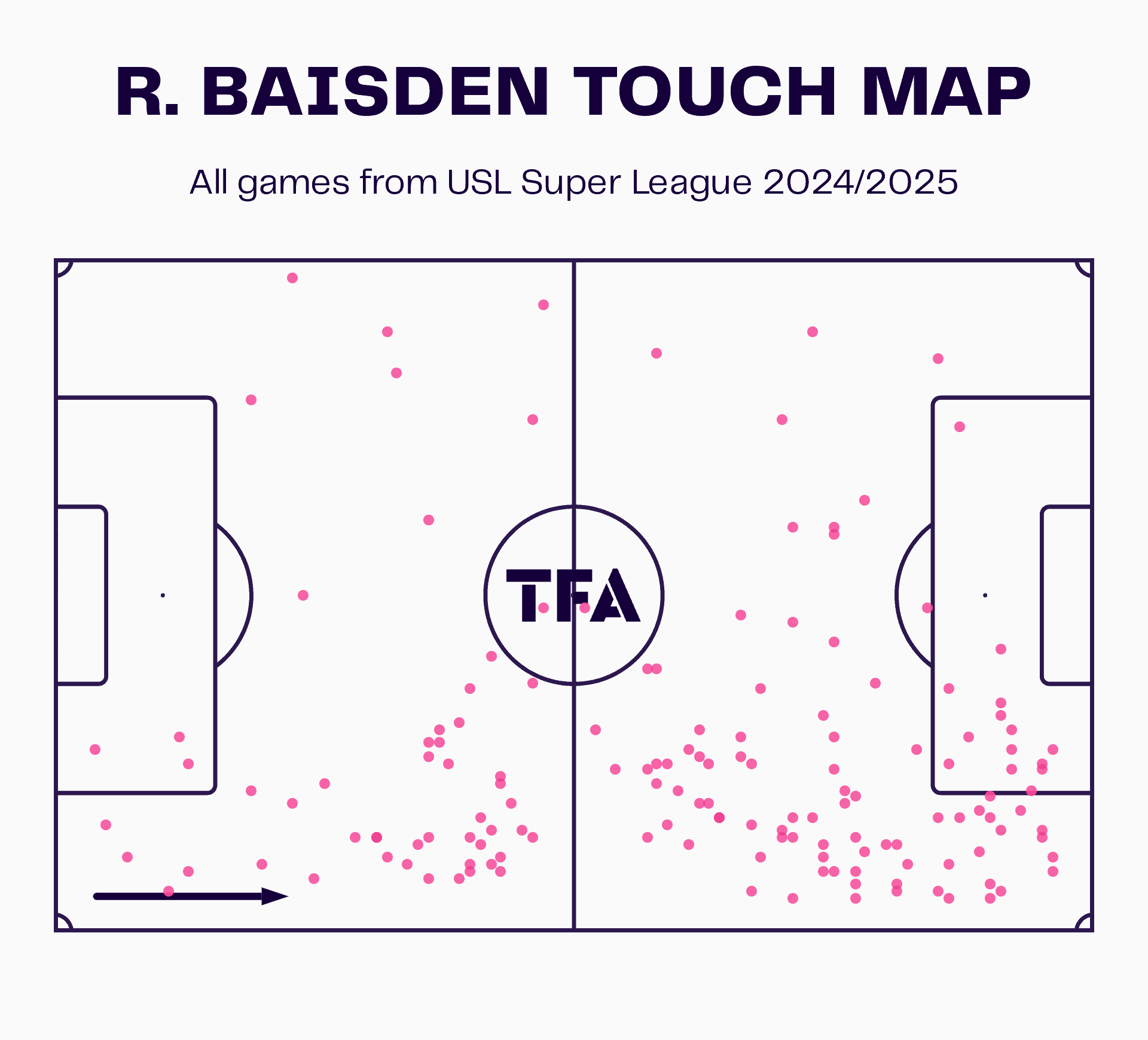
This is not the only time that Baisden has made a move of this nature to create transitional opportunities and to put doubt in the minds of her team’s opponents.
She has really epitomised that aspect of Carolina’s tactics during their opening four matches.
This graphic highlights how she has had plenty of touches on the right wing but has also been seen moving inside the field on a number of occasions.
A number of her touches of the ball have come in central spaces and on the opposite wing, too.
This likely attracted Poole to her services when he assembled his squad for the campaign, and there is no doubt that she has made a really bright start in her new surroundings.
Keeping her fit will be vital if the Ascent are to retain their place among the early title contenders.
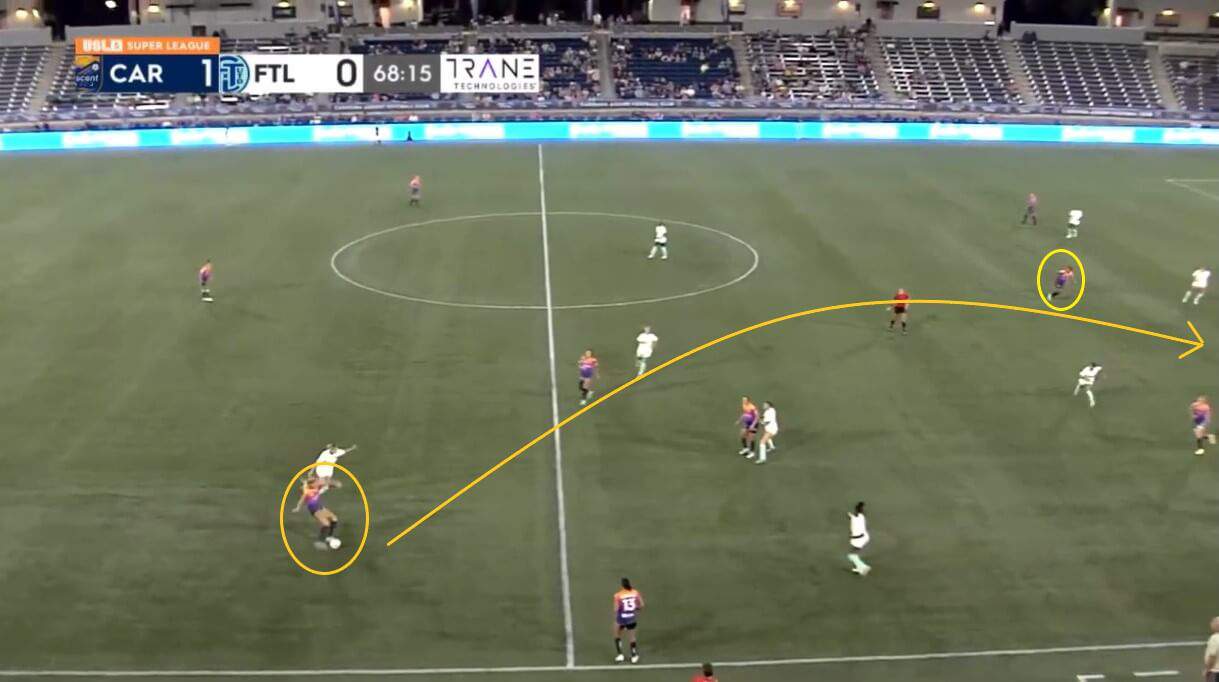
As was mentioned earlier in the scout report, though, what has made Carolina so tricky to play against is that they can change things up whenever those tactics lack the desired effect.
The match against Fort Lauderdale (coached by former Premier League player Tyrone Mears) was one when they did need to adapt.
They recognised that pursuing those passing sequences in transition was not having as much success as they would have hoped for, largely due to the visitors being fairly solid in the central third.
As a result, Carolina turned to a more direct style of play and sought to move the ball aerially whenever they could, just as Studer is doing here.
In this case, she has noticed that there is a gap inside the final third and that forward Mia Corbin is in a position to run onto anything that is sent her direction.
So, she makes the long pass and allows the attacker to break behind the Fort Lauderdale back line.
The move eventually resulted in a goal from Puerto Rico midfielder Jill Aguilera, who had cut inside from the far side wing. Undoubtedly, this was just as effective a strategy for Carolina to employ.
The fact that they have a 55.9% accuracy for passes to the final third so far highlights how this is another key strength in their overall game.
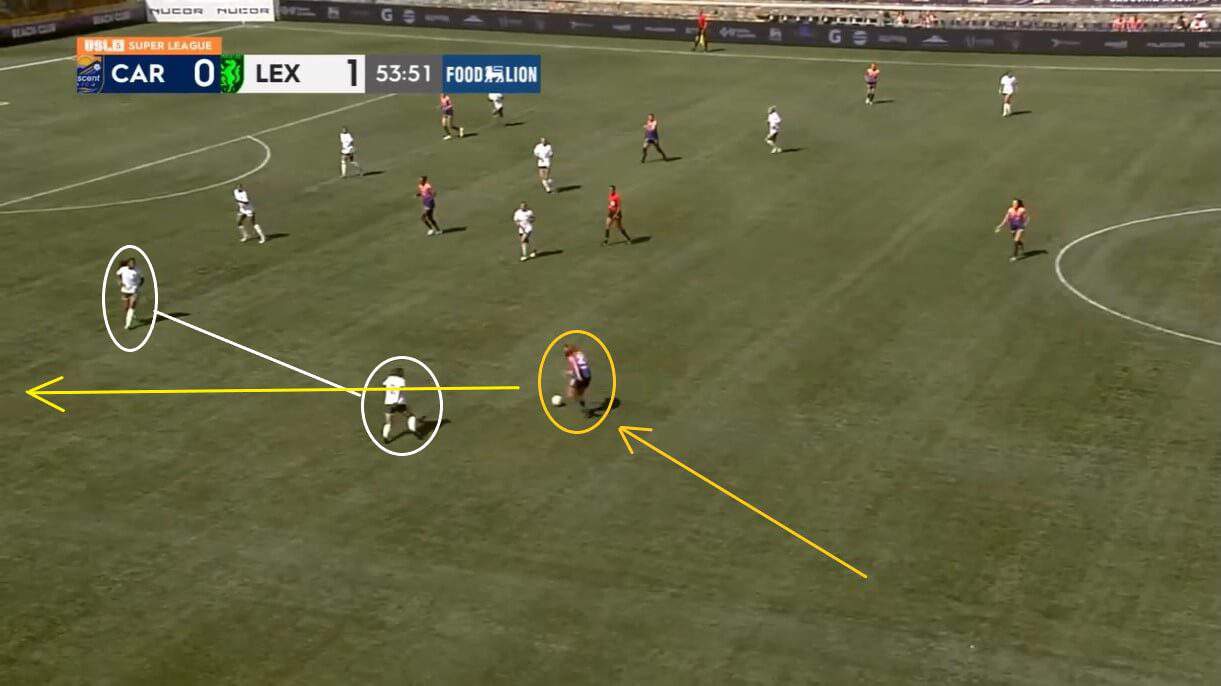
There have been occasions when they have needed to tweak their tactics even further, though.
The match against Lexington was one such occasion, as neither of those styles of play would have worked for them.
This was largely due to the away team pressing aggressively and organised from the front from the start and then falling back into solid shape whenever they needed to prioritise protecting their goal.
There is no doubt that they had the better first half on balance.
As a result, the Ascent turned their attention to dribbling with the ball more and trying to create spaces by manipulating the Lexington players.
To do this, they made more inverted runs from the wings and tried to force Lexington into becoming more compact, knowing that doing so would lead to additional space on the wings that they could then use to their advantage.
In many ways, it was similar to what they did against Fort Lauderdale, except that they weren’t looking to pass the ball this time.
Instead, as left-back Renée Guion is doing here, they kept the ball for longer periods and tried to drag their opponents into the middle of the pitch.
On this occasion, it worked out well for them in that sense, with both Kailey Utley and Autumn Weeks following Guion’s progress and opening up the opportunity for the left-back to then feed the ball back out towards Dominican Republic forward Kathrynn González.
The move might not have led to anything on this occasion, but what it highlights is just how adaptable Carolina are whenever fashioning goalscoring opportunities, and this is certainly something to keep an eye on throughout the Super League campaign.
Carolina Ascent’s Defensive Shape
As mentioned, though, it is not all about attacking.
What has also helped Carolina Ascent look so formidable is their ability to match that with defensive rigidity.
The analysis already highlights that their four matches so far have yielded two clean sheets (the most in the division), and there is no doubt that this part of their game has contributed just as much to their positive start.

As with many teams in the Super League, Carolina’s intention is to take the game to their opponents whenever they can, with them instigating a high press whenever they can and constantly seeking to compress the spaces that their opponents have to operate in.
This comes mainly through the advanced positioning of their back line.
It is common to see those players situated around the halfway line or even further up the pitch, just as they are here against Spokane Zephyr.
This increases Carolina’s potential to move the ball around and connect with each other.
Players ahead of them are much closer together, therefore decreasing the distance that each pass needs to cover.
It also provides additional passing options, which further hinder their opponents’ opportunities to encircle it.
The other advantage of playing in such an aggressive manner is that it increases their potential to be more direct while retaining the overall accuracy of their transitions.
In this case, the ball is at the feet of centre-back Vicky Bruce (formerly of Bristol City Women and most recently of Western Sydney Wanderers Women), and she only has one thing on her mind: to send it forward and into the path of forward Audrey Harding, which she does with unerring precision.
This is not to say that they would have struggled to make the same pass from further back, but it certainly helps that there is less distance for the ball to travel from the backline to the forwards.
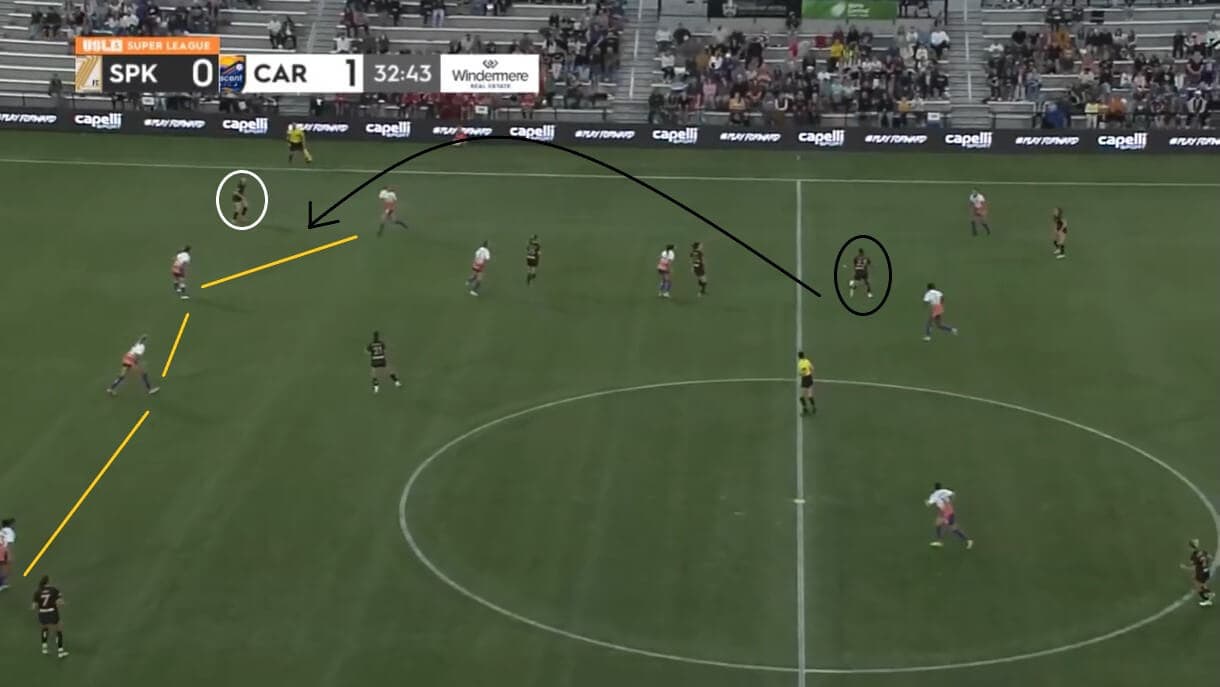
It is not a system without its risks, though.
One of the more obvious issues is that it leaves a vast amount of territory unprotected behind the backline.
There have been a number of occasions when this has caught the Ascent out, with Spokane being one of those who use their opponents’ occasional tardiness in tracking back against them.
As the season has gone on, it has become obvious that Spokane’s tactics are based around being expansive and utilising their wide threats whenever they can.
There is no doubting the impact that the likes of Bosnia’s former Racing Louisville and Melbourne City Women forward Emina Ekić have had on their performances so far when allowed to compete in 1-v-1 duels.
It therefore came as a surprise to see Carolina allowing her so much time and space to get the ball down and to create problems, with Guion here edging forward in an attempt to press (but in an unconvincing manner) and making it far too easy for Marley Canales to target her with an accurate aerial pass.
This is certainly one area where Carolina needs to be wary about playing into their opponents’ hands, and it serves as a stark reminder that they are not the finished product yet.
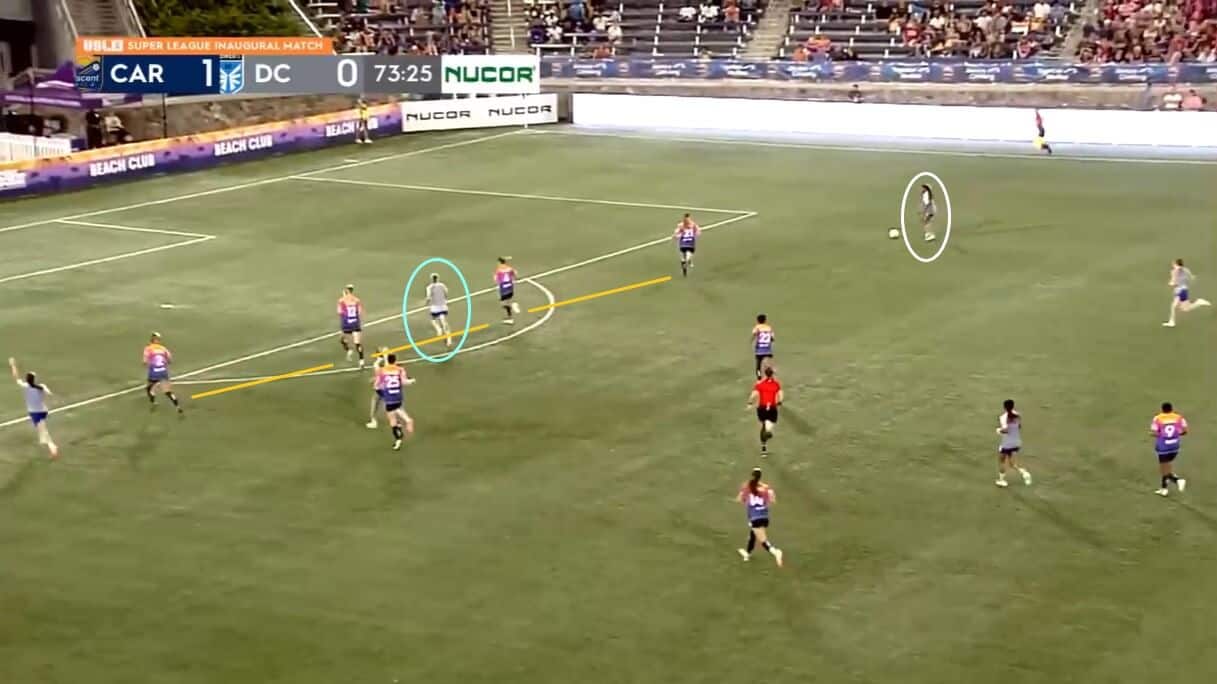
However, when they do get the detail of their play right, they do have the appearance of a largely immovable object, and it is no surprise that they have succeeded in 61.4% of their defensive duels and 47.8% of their aerial duels so far when looking at how well-organised they can be.
Their desire to be so tough to break down was apparent from their opening match against DC Power when they recognised their opponents’ intention to be direct and to utilise the goalscoring threat of former Hibernian Women striker Jorian Baucom, who scored 25 goals in the SWPL 1 last time out.
In order to minimise the chances of DC finding their target player, Carolina knew that they would need to sit further back and cede territory ahead of them by not pressing forward as often, and it largely worked out for them as they restricted the number of chances that Baucom had.
In this case, the ball has been fed out to winger Mariah Lee, but she has not been able to find her teammate because Carolina’s line discipline has been regimentally maintained.
Therefore, when Carolina do stay focused, they are a very tough side to come up against, and that will stand them in good stead as the season goes on and they strive to become the Super League’s inaugural champions.
Carolina Ascent’s Areas To Work On
Much of the analysis so far has been centred around the positive aspects of Carolina Ascent’s play, and there is certainly great cause for optimism regarding their playoff hopes and title challenge.
However, it is important not to get too carried away and to remember that this is still a new squad in a new league.
They are a continual work in progress, and there are certainly a few areas where they can still tighten things up.
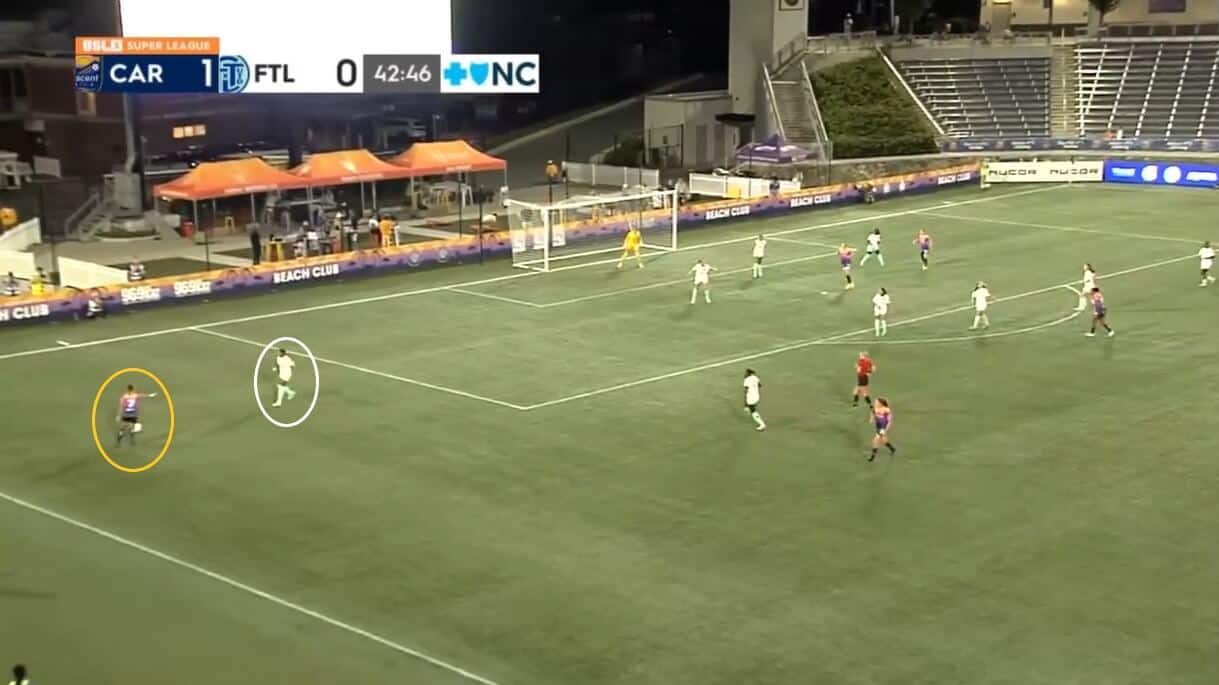
The first of those is their deliveries into the middle from wider positions, with it mentioned that they make use of the wings when building from the back and when progressing up the field.
However, when the ball arrives in the final third, that has tended to be where a lot of attacks have broken down prematurely.
This is just one example of that happening, with Guion making a typical run up the wing and receiving the ball from inside the pitch.
Her intention now is to send it back into the middle and set up a shot on goal.
She does have former Birmingham City Women player Adrienne Jordan (who has also featured in the Frauen-Bundesliga during her career) closing her down, but the Fort Lauderdale player has not got tight enough to prevent the cross from coming about, and so is not giving Guion anything to worry about.
For that reason, the cross disappointed so much, with the ball evading those Carolina players waiting in the box and allowing Fort Lauderdale to regain the ball in very cheap circumstances.
With them having just a 29.4% crossing accuracy so far (seeing 15 of 51 attempted deliveries find their intended target), this is certainly a recurring theme of their play and is something that they need to address if they are to keep winning matches and making life as difficult as possible for their opponents.
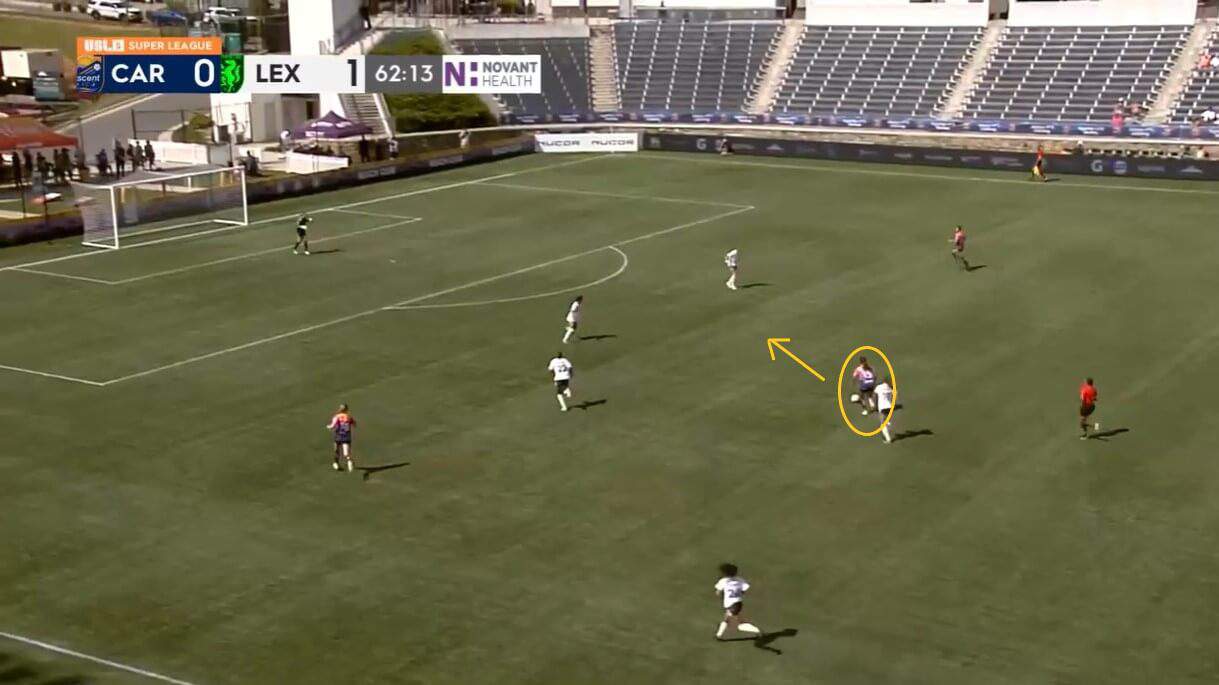
The other thing that has been lacking at times is their decision-making.
There is no doubt that some of their wins could have been acquired more comfortably and that they have left goals out on the field at times.
The match against Lexington was one of those.
As mentioned, the Kentucky side enjoyed a strong first half, and the Ascent needed to ensure that they capitalised on those moments to test their opponents’ resolve.
However, this was one situation when they failed to do that, with González receiving the ball as part of a counterattack and driving infield.
She has two players on either side of her that she can select between to move the ball beyond the Lexington back line.
Both would have had space to affect the game, but González ended up keeping the ball and shooting at goal herself from a more central position.
The effort lacked direction because the players in front of her held firm and failed to trouble goalkeeper Bridgette Skiba.
Therefore, whilst Carolina have scored six goals to date (the second-highest tally in the division at the time of writing) and have seen 66.7% of their counterattacks lead to a shot on goal, they will know that they could have been a lot more productive in some of their games and that they will need to start putting more of these opportunities away if they are to extend their stay at the league’s summit.
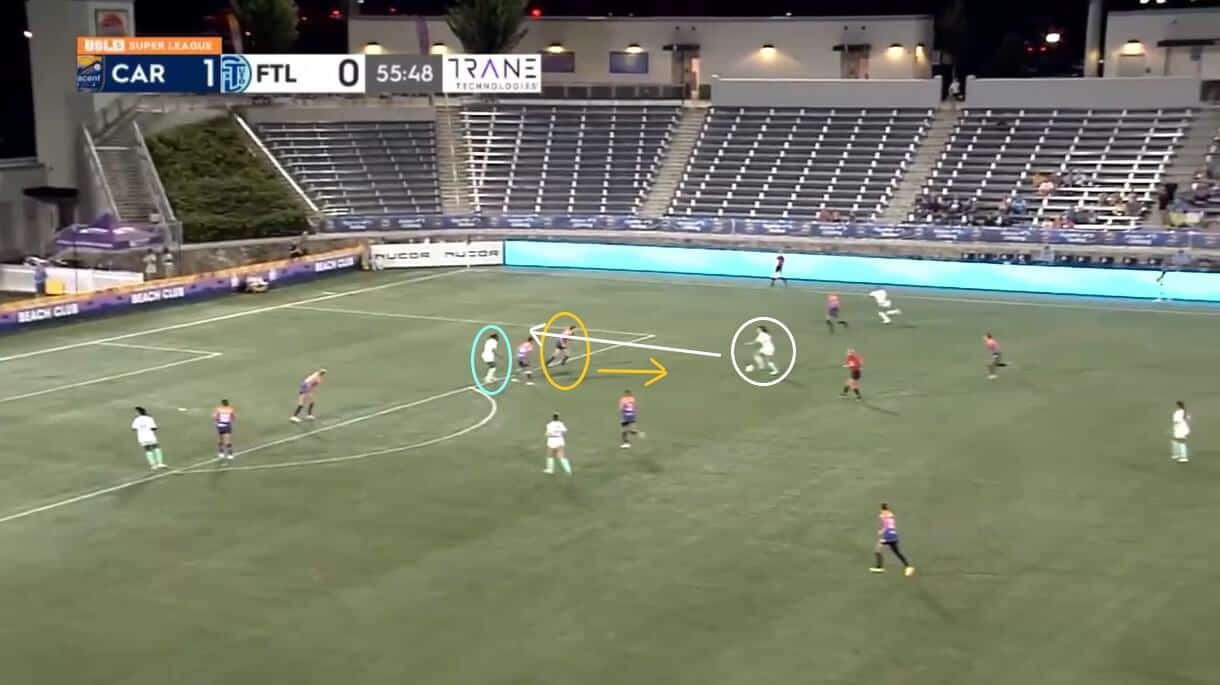
Questionable decision-making is not solely restricted to when they are on the front foot, though, and it has been seen further back, too.
In this case, Fort Lauderdale have the ball and Addie McCain is looking to create a goalscoring opportunity, with Sh’Nia Gordon ahead of her.
However, standing between the two players are the duo of Bruce and Guion, who are positioned close to each other and who look to have halted any attempt by their opponents to move the ball into the goal area here.
That is certainly the case until Guion makes a split-second decision and tries to once again close the ball down.
She doesn’t do so with any confidence, so she allows McCain to send the ball around her and into Gordon’s path.
On this occasion, the cross from Gordon was met by Studer, and Carolina was able to clear their lines.
However, it was another situation in which Carolina was the source of their own undoing.
It comes down to knowing when to take a front-footed approach and when to focus instead on staying together and being tough to beat.
Conclusion
In conclusion, this tactical analysis has looked in detail at Carolina Ascent’s start to the all-new USL Super League, highlighting the many positives in their play and the areas that they can work on as the campaign goes on.
As has been apparent throughout much of the scout report, there is a lot to like about the direction that the Ascent are currently going in, with it clear to see how they have a game plan on the field and a style of play that every member of the squad has bought into.
The adaptability that has been present is also especially noteworthy.
It indicates how they have sought to prepare themselves for every eventuality so they never leave themselves without a way of testing their opponents.
The signs are good for Carolina, but it will now be about staying focused and not becoming complacent as the season goes on.
The Super League might still be in its infancy, but it is already clear that every team can win on their day.
Therefore, nothing should be taken for granted, and Carolina should go into each game expecting a battle.

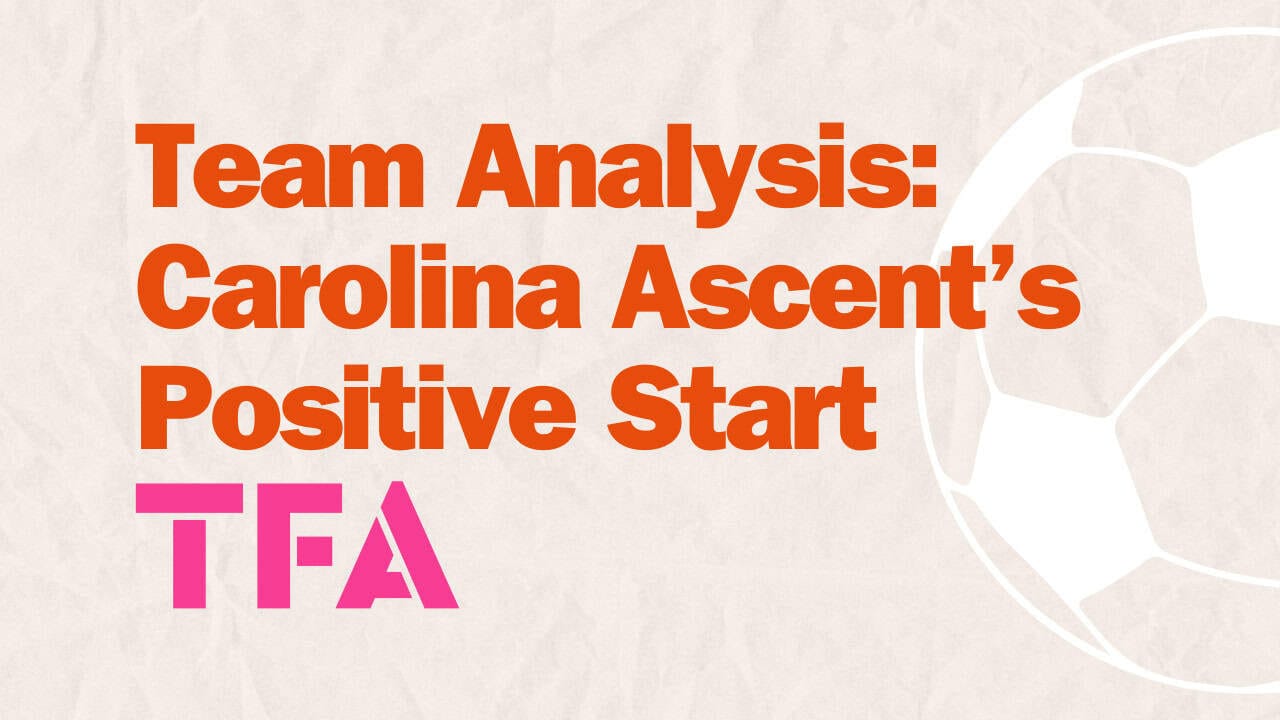



Comments